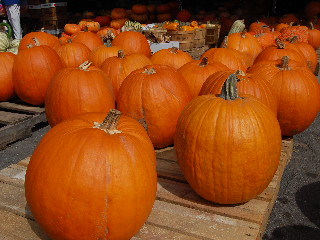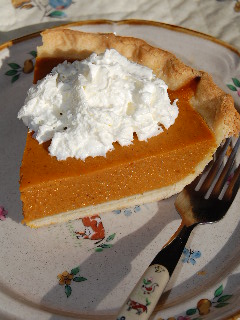
Okay, kids, let's talk about pumpkins today! What’s not to love about pumpkins? They’re easy to grow, healthy to eat, and fun to carve into Jack O’Lanterns!
Pumpkins can be grown by starting seeds indoors while the weather is still cool, or the seeds can be planted directly into your garden once all danger of frost has past and the soil has started to warm-up.
Planting them in hills or mounds of organically rich garden soil is the best way to grow your pumpkins. Put 8 to 10 seeds in each mound and space the mounds about 10 feet apart. This allows plenty of room for the vines to run and room for the pumpkins to grow and develop to their maximum size.
Pumpkin vines need lots of sunshine and warm temperatures and plenty of water in order to thrive and produce lush, healthy, nutrient-rich pumpkins.
Okay, that’s the “easy to grow” part of the story; now on to the “healthy to eat” aspect of this presentation! Quickly now, kids, what color do we expect most pumpkins to be? Orange, of course! And orange you the smartest bunch of students I’ve ever taught!? No groaning at my jokes, Timmy, if you expect an A in this class!
Now, just a little bit tougher question for you—what do we know about those orange colored foods? ……….. excellent answer, Becky Ann, they are indeed rich in beta carotene, which helps to lower the risk of heart disease.
And, in addition to containing beta carotene, pumpkins are also high in potassium and Vitamins A and C, as well as being a good source of fiber in your diet. They are very low in fat and calories and contain no cholesterol.
Pumpkins can be baked into muffins, breads, cakes, and . . .(this is what made pumpkins famous!). . . delicious pumpkin pies! For a little variation on that kitchen classic, just choose your favorite pumpkin pie recipe, add a package of softened tofu, and leave out the eggs and milk entirely. Season appropriately with cinnamon and nutmeg or other pumpkin pie spices, bake in a sprayed pie pan without using a pie crust, and you’ve got a delicious dessert that’s low in fat, calories, and cholesterol. Even crazy ol’ Uncle Hector will love it and he’ll never know that he’s eating healthier!

Now, kids, let’s talk a little bit about the science and the history of our orange friends.
Pumpkins are in the same family (Cucurbita) as squash, gourds, cucumbers, and watermelons. And, they actually originated in the Americas and were already being grown and consumed by the Native American people when the first white settlers arrived. Not only that, but…… yes, Sarah, you’re asking how an orange food grown by Native Americans came to be associated with spooks and Halloween….good question!
Well. . . .Halloween, which originated as All Hallows Eve in Europe long ago, was a harvest celebration and a festival to honor the dead. Festival-goers would carve scary faces into gourds and other fruits and fill them with lighted candles or burning embers to frighten away the evil spirits.
The Irish often carved turnips or potatoes for their light-bearing vessels, and they called them Jack O’Lanterns (what a great Irish name, huh?). When the Irish immigrated to America in the 1800’s, they found that those big orange, hollow-on-the-inside pumpkins made really great and easy to carve light bearers—thus the pumpkin Jack O’Lanterns on Halloween!
Here’s another laugh for you, kids. When you get home tonight, ask your mom if it’s really not polite to play with your food. When she says, “Of course it's not!”, then ask her how you’ll be able to carve a funny face into your pumpkin at Halloween!
She’ll think this is hilarious! If she doesn’t, then just don’t tell her Mr. Gardenvoice told you that joke!
You've been a great group--thanks, kids!
 Okay, kids, let's talk about pumpkins today! What’s not to love about pumpkins? They’re easy to grow, healthy to eat, and fun to carve into Jack O’Lanterns!
Okay, kids, let's talk about pumpkins today! What’s not to love about pumpkins? They’re easy to grow, healthy to eat, and fun to carve into Jack O’Lanterns!
 Now, kids, let’s talk a little bit about the science and the history of our orange friends.
Now, kids, let’s talk a little bit about the science and the history of our orange friends.